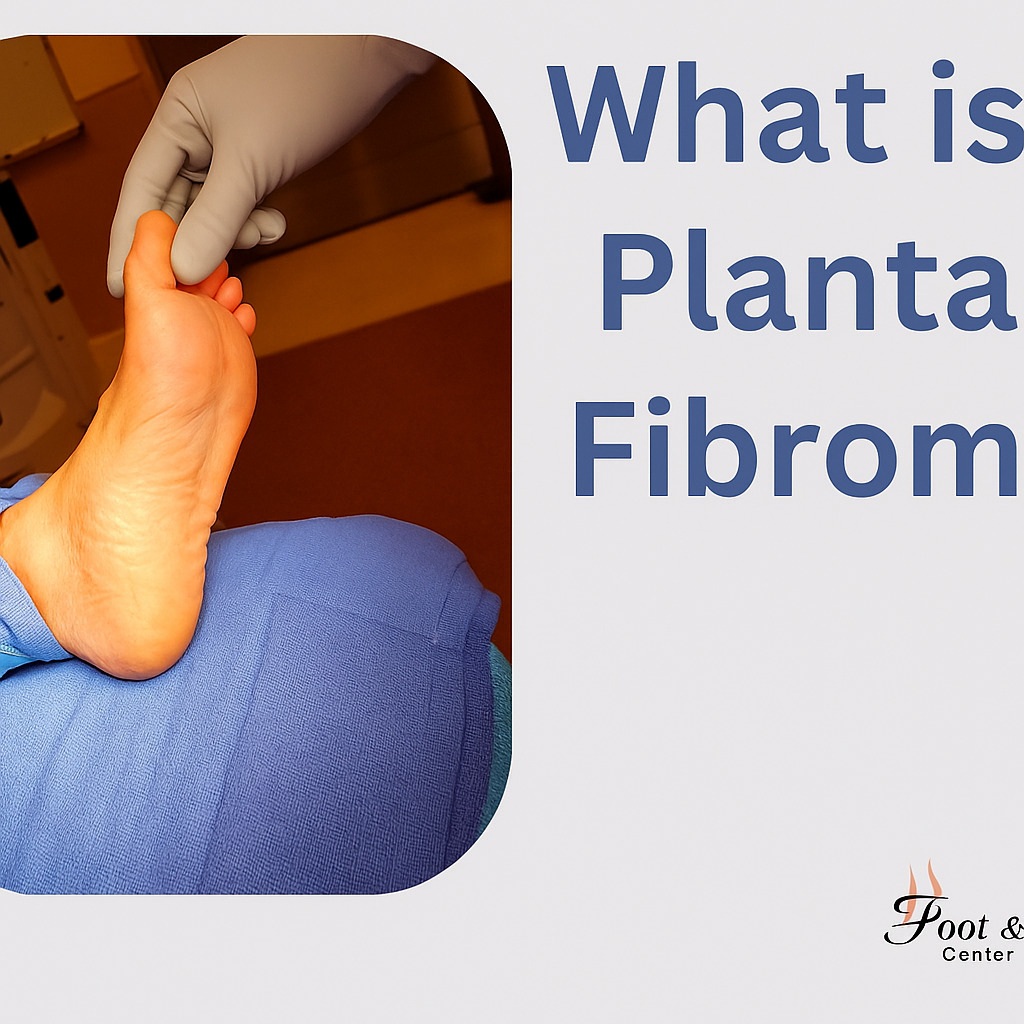If you’ve ever felt a small, firm lump in the arch of your foot and wondered, “What is a plantar fibroma?” — you’re not alone. This lesser-known foot condition can cause discomfort, disrupt your walking pattern, and impact your daily life. Fortunately, understanding the nature of a plantar fibroma can help you seek the right treatment early and avoid long-term complications.
What Is a Plantar Fibroma?
A plantar fibroma is a noncancerous (benign) nodule that develops in the plantar fascia — the thick ligament that runs along the bottom of your foot. It typically appears as a small, firm lump in the arch and may grow slowly over time. While it’s usually not dangerous, it can become painful or problematic, especially if it interferes with walking or footwear.
The condition affects both men and women and can occur in one or both feet. Although its exact cause is unknown, some people may be more genetically predisposed to developing it.
What Causes a Plantar Fibroma?
While the precise cause remains unclear, several factors may contribute to the development of a plantar fibroma:
- Repetitive stress or trauma to the foot
- Genetics – more common in individuals of Northern European descent
- Medical conditions – such as Dupuytren’s contracture or Peyronie’s disease
- Footwear that lacks support or irritates the arch
Still wondering what is a plantar fibroma and why it shows up? Think of it as your body’s response to minor injury — an overgrowth of fibrous tissue that builds up into a mass.
Signs and Symptoms
The most obvious sign of a plantar fibroma is a visible or palpable lump in the arch of the foot. Other symptoms may include:
- A firm, round nodule embedded in the sole
- Pain or discomfort, especially when walking barefoot or in tight shoes
- Tenderness when pressure is applied
- Difficulty finding comfortable footwear
While some individuals experience no pain at all, others may find walking, running, or even standing becomes uncomfortable over time.
How Is a Plantar Fibroma Diagnosed?
A proper diagnosis typically starts with a physical examination by a foot and ankle specialist. The doctor will gently press on the lump to assess its size, location, and tenderness. Additional tests may include:
- Ultrasound – to visualize the lump and differentiate it from other soft tissue masses
- MRI (Magnetic Resonance Imaging) – to get a detailed view of the fibroma and surrounding tissue
- Biopsy – in rare cases, to confirm the growth is benign
If you’re asking, “What is a plantar fibroma and how do I know I have it?” — seeing a podiatrist for an accurate diagnosis is the first step.
Non-Surgical Treatment Options
In many cases, conservative treatment is enough to relieve symptoms and manage the condition. Options include:
1. Custom Orthotics
Specially designed shoe inserts can redistribute weight away from the fibroma, reducing pressure and discomfort.
2. Steroid Injections
Corticosteroids may shrink the fibroma temporarily and help reduce inflammation. However, the fibroma may return to its original size over time.
3. Physical Therapy
Techniques such as massage, ultrasound therapy, and iontophoresis (delivering medication through the skin) may help alleviate pain and limit growth.
4. Over-the-Counter Insoles
While not as effective as custom orthotics, padded insoles can provide some relief for mild cases.
If you’ve been diagnosed and are wondering what is a plantar fibroma treatment like, it’s best to start with these conservative methods before considering surgery.
When Is Surgery Necessary?
Surgery is considered when:
- Conservative treatments fail to relieve symptoms
- The fibroma is growing rapidly
- Daily activities are limited due to pain
The surgical procedure involves removing the fibroma and part of the affected plantar fascia. While this can provide long-term relief, it also carries risks:
- Arch instability or flattening
- Formation of hammertoes
- Recurrence of the fibroma
- Prolonged recovery period
Patients typically need to wear orthotics post-surgery to support the arch and prevent complications.
Recovery Timeline
If you undergo surgical removal, recovery may take 6 to 8 weeks or longer, depending on the size of the fibroma and your activity level. You may need:
- Crutches or a walking boot during early recovery
- Physical therapy to regain strength and mobility
- Regular check-ins with your foot and ankle specialist
Even if you’re pain-free after surgery, it’s essential to wear proper footwear and stay vigilant for any signs of recurrence.
Can a Plantar Fibroma Go Away on Its Own?
Unfortunately, plantar fibromas do not typically go away without treatment. While pain may be managed conservatively, the fibroma usually remains — and in some cases, it may grow. That’s why seeking professional care early can help you avoid complications and preserve your quality of life.
Living With a Plantar Fibroma
If you’re managing a plantar fibroma without surgery, here are some tips:
- Wear supportive footwear at all times, even indoors
- Avoid walking barefoot, especially on hard surfaces
- Monitor the size of the lump and any changes in pain level
- Follow up regularly with your podiatrist
Understanding what is a plantar fibroma helps you make informed decisions about your foot health. While the condition can be persistent, it is manageable with the right care and attention.
Why See a Podiatrist?
A foot and ankle specialist is trained to identify and treat plantar fibromas and other soft tissue conditions in the foot. They can:
- Accurately diagnose the condition
- Recommend the best treatment for your lifestyle
- Monitor changes in the fibroma over time
- Perform surgical interventions if needed
So, if you’re still asking what is a plantar fibroma and do I need to treat it? — the answer is yes. Even if it’s not currently painful, a fibroma can worsen and become more difficult to manage without early intervention.
Final Thoughts
What is a plantar fibroma? It’s a benign lump in the arch of your foot that can cause discomfort and interfere with everyday activities. While it may sound minor, this condition requires proper evaluation and care to avoid chronic pain or long-term foot damage.
If you suspect you may have a plantar fibroma, consult a podiatrist today for diagnosis and a customized treatment plan. With proactive care, you can stay mobile, comfortable, and pain-free — one step at a time.
FAQ
Q: Is a plantar fibroma the same as plantar fasciitis?
A: No, plantar fibroma is a lump in the fascia, while plantar fasciitis involves inflammation and heel pain. Both affect the plantar fascia but are distinct conditions.
Q: Can I exercise with a plantar fibroma?
A: Yes, but it depends on the severity. Low-impact activities and proper footwear can help reduce strain on the fibroma.
Q: Are there any home remedies for plantar fibroma?
A: While you can manage symptoms with ice, foot massage, and cushioned footwear, professional treatment is necessary for long-term relief.




